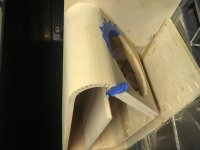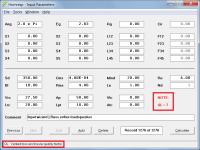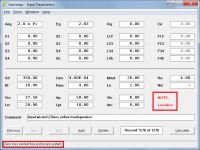I gotta hurry and come up with more long excessively worded descriptions of redundant ideas with cartoon drawing then! I’m
Falling behind !
More segments equals ease of folding and true modeling representation. Plus, I'm a car audio guy at heart. Most car audio drivers are not TH friendly with 4 segments. That being said, I have yet to put a TH in a car/truck/SUV. I'm BP6 for home and BP4 for car, hence BP1FANATIC! TH's are series tuned BP6's.
Last edited:
is it possible to pass on command-line arguments to Hornresp?
No.
Posts #7911 and #7912 linked below also refer.
https://www.diyaudio.com/forums/subwoofers/119854-hornresp-792.html#post5227066
https://www.diyaudio.com/forums/subwoofers/119854-hornresp-792.html#post5227543
Here’s an example of a very useful tool In horn response and a way to know what to call something or what it is maybe?
Along time ago (more than a year) I made this for my son but I hadn’t learned how to sim anything and it was a mystery In many ways and never measuring it or knowing, we didnt kniw why weliked it and he has changed vehicles since so it’s long gone. But I had a drawing and recently found it. it occurred to me that i have never actually made a TL or MLTL. Even to this day fir that application, It was actually all tapped pipe (TH) or similar that I have been and had been. it’s not as obvious until you look. but I’m sure glad I did. it explains a lot.
Along time ago (more than a year) I made this for my son but I hadn’t learned how to sim anything and it was a mystery In many ways and never measuring it or knowing, we didnt kniw why weliked it and he has changed vehicles since so it’s long gone. But I had a drawing and recently found it. it occurred to me that i have never actually made a TL or MLTL. Even to this day fir that application, It was actually all tapped pipe (TH) or similar that I have been and had been. it’s not as obvious until you look. but I’m sure glad I did. it explains a lot.
Attachments
It looks to be screw holesloooking good!!!!
May I ask what the purpose of the lamellos on the bottom panel is?
loooking good!!!!
May I ask what the purpose of the lamellos on the bottom panel is?
Poor planing back then. Too much motivation and not enough concentration. just rookie without a clue.
Pocket screw holes predrilled that end up inaccessible to use,
No.
Posts #7911 and #7912 linked below also refer.
https://www.diyaudio.com/forums/subwoofers/119854-hornresp-792.html#post5227066
https://www.diyaudio.com/forums/subwoofers/119854-hornresp-792.html#post5227543
Understood,... with some disappointment
Hello,
I'm French so sorry for my bad English
I have noticed that there is a difference for BRs since the new versions.
For example with a Hybrid (BR + Horn) the port outputs 4dB less on the latest version, but tuned to the same frequency.
With Akabak I get a result close to the old version.
Why has this changed?
Thank you for your help and your great software!
I'm French so sorry for my bad English
I have noticed that there is a difference for BRs since the new versions.
For example with a Hybrid (BR + Horn) the port outputs 4dB less on the latest version, but tuned to the same frequency.
With Akabak I get a result close to the old version.
Why has this changed?
Thank you for your help and your great software!
Hi Phonetik,
There is absolutely nothing wrong with your English - it is certainly infinitely better than my French... .
.
I am not sure why the port output should have changed. To allow me to investigate further would it be possible for you to provide an example of a design that produces the different values? Also, what was the Product Number of your earlier version? Many thanks.
Kind regards,
David
I'm French so sorry for my bad English
There is absolutely nothing wrong with your English - it is certainly infinitely better than my French...
For example with a Hybrid (BR + Horn) the port outputs 4dB less on the latest version, but tuned to the same frequency.
I am not sure why the port output should have changed. To allow me to investigate further would it be possible for you to provide an example of a design that produces the different values? Also, what was the Product Number of your earlier version? Many thanks.
Kind regards,
David
Hi Phonetik,
There is no need for you to provide a design example .
.
The reason for the difference is because system losses in a vented-box enclosure are now taken into account using the QL quality factor parameter - the default value is 7.
When set to "Lossless", the results will be the same as before. See the Help file for further details.
Kind regards,
David
There is no need for you to provide a design example
The reason for the difference is because system losses in a vented-box enclosure are now taken into account using the QL quality factor parameter - the default value is 7.
When set to "Lossless", the results will be the same as before. See the Help file for further details.
Kind regards,
David
Attachments
Hi David,
Thank you for your answer !
Why is the QL parameter not available in Horn + BR?
Currently we have to modify it when we are in classic BR and then do the Horn. But you can't modify it afterwards, or you have to remove the Horn, modify QL, then redo the Horn.
Is there another method?
Thank you!
Thank you for your answer !
Why is the QL parameter not available in Horn + BR?
Currently we have to modify it when we are in classic BR and then do the Horn. But you can't modify it afterwards, or you have to remove the Horn, modify QL, then redo the Horn.
Is there another method?
Thank you!
Hi Phonetik,
Sorry, I should have explained why in my second message yesterday, and was going to do so today but you posted again before I could get back to you .
.
The intention was for the system loss feature to apply to standard "normal" and "offset" bass reflex systems only. When the feature was added to Hornresp I completely forgot about the Horn + BR possibility, and so system loss was inadvertently included for that system type also, even though it was not possible to access the QL parameter.
When you referred to "Hybrid (BR + Horn)" in your first message I immediately realised that I had made an error. It will be fixed in the next update (the relevant code has already been corrected). Horn + BR systems will become completely lossless again. Only standard BR systems will keep the system loss feature, as was the original plan.
Thanks for bringing the oversight to my attention!
Kind regards,
David
Why is the QL parameter not available in Horn + BR?
Sorry, I should have explained why in my second message yesterday, and was going to do so today but you posted again before I could get back to you
The intention was for the system loss feature to apply to standard "normal" and "offset" bass reflex systems only. When the feature was added to Hornresp I completely forgot about the Horn + BR possibility, and so system loss was inadvertently included for that system type also, even though it was not possible to access the QL parameter.
When you referred to "Hybrid (BR + Horn)" in your first message I immediately realised that I had made an error. It will be fixed in the next update (the relevant code has already been corrected). Horn + BR systems will become completely lossless again. Only standard BR systems will keep the system loss feature, as was the original plan.
Thanks for bringing the oversight to my attention!
Kind regards,
David
why not put the QL parameters for Horn + BR ?
I wanted to keep things as simple and as consistent as possible. I would rather not have the situation where system losses are included for some loudspeaker types, but not for others. After feedback from users I was persuaded to treat the direct radiator bass reflex loudspeaker as a special case and allow for system losses, but that is as far as I am prepared to go, particularly as the loss value is somewhat of a "guesstimate" anyway.
- Home
- Loudspeakers
- Subwoofers
- Hornresp


